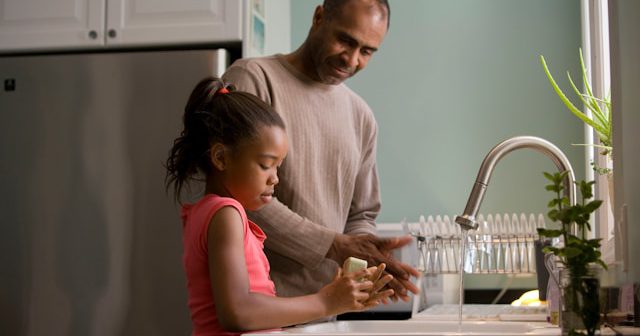As parents, it’s our job to keep our children safe. We do everything in our power to create a secure, nurturing environment for them, from baby-proofing sharp corners to filling our homes with stimulating toys. However, some health risks are harder to detect, yet they could be lurking around your home. Here’s a look at some common environmental hazards and the steps you can take to protect your family’s health.
-
Asbestos Exposure
Asbestos is a naturally occurring mineral and, thanks to its durability and heat resistance, it was widely used in building materials and household products. Unfortunately, asbestos fibers are also extremely dangerous. When inhaled, especially over a long period of time, they can lead to respiratory diseases like mesothelioma, a rare and aggressive cancer.
While there are many free resources and support services for asbestos-caused illnesses, like Mesothelioma Hope, the best way to protect your children is to avoid all asbestos exposure. If your home was built before the 1980s, speak to an expert who can assess and if necessary, remove any asbestos.
-
Mold and Indoor Air Quality
Mold is more than an unsightly nuisance: it can cause allergies, asthma, and other serious respiratory issues in your children. Bathrooms, basements, and kitchens are common areas for mold, as they tend to be the most humid. Keep these places well-ventilated and address any moisture build-up as soon as you notice it to prevent mold growth.
-
Pesticides and Household Chemicals
Pesticides, household chemicals, and some cleaning products can pose health risks to your children if stored or used improperly. Young children are more susceptible to these chemicals because they’re still developing and are more likely to come into direct contact with contaminated surfaces, like floors and walls.
The best course of action is to opt for non-toxic, eco-friendly products for cleaning and pest control. Be sure to store all chemicals out of your children’s reach and keep them clearly and correctly labeled. If you use pesticides or strong chemicals in the home or garden, restrict children’s access until the product has dissipated, or at least cover the affected area.
-
Water Quality
Getting your kids to drink enough can be a challenge as it is, but when it comes to water, it’s not only about quantity; the quality matters, too. Contaminants like lead, chlorine, and bacteria in your home’s water supply can pose a serious risk to your kids’ health. The best thing you can do is install a household water filtration system. This will not only keep your little ones safe, but it improves the taste too!
-
Radon
Radon is a radioactive gas that’s found everywhere, and most of the time, it causes no issues. However, in areas where it’s more concentrated, this colorless, odorless, and tasteless gas can have long-term health implications. To protect your children from high levels of radon, research the radon presence in your area or get a testing kit. Thankfully, there are plenty of radon mitigation systems you can install in your home if necessary.
Endnote
Protecting your children’s health goes beyond decking out your home with child-friendly furnishings. Asbestos, mold, radon, household chemicals, and even water present unseen hazards that can cause adverse health effects, especially in developing children. By taking proactive measures, you can reduce exposure to these risks and create a healthier, safer environment for your family.





Exposure to outdoor and indoor air pollution, such as vehicle emissions or household smoke, can lead to respiratory issues in children, including asthma and allergies. Ensure good ventilation and reduce exposure to pollutants.
Effervescent energy tablets
As a parent, being mindful of environmental health risks is crucial to safeguarding your child’s well-being. Common threats include air pollution, which can cause respiratory problems, lead exposure from older homes, and harmful pesticides in foods or outdoor environments. Toxins in household products like cleaning agents, and contaminated water sources, are also significant risks. By staying informed about these dangers, you can take steps to minimize exposure, ensuring a healthier home environment for your family.
Eco friendly promotional phone holders
Exercise is medicine for the mind and body. It reduces stress, boosts energy, and strengthens your health. Get moving today. Nourish your body with healthy food and your soul with positive thoughts. A balanced approach leads to lasting health and happiness.
where to buy boostaro
Knowledge sharing is a cornerstone of healthcare innovation, fostering collaboration and improved patient care. By exchanging insights and best practices, professionals can tackle challenges effectively and stay updated with advancements. Empowering healthcare teams with continuous learning tools ensures better decision-making, enhanced outcomes, and a more resilient, informed healthcare system.
physiotherapist gold coast
“Your health is your wealth—always make time for proper nutrition, exercise, and rest!”
Knowledge sharing is a cornerstone of healthcare innovation, fostering collaboration and improved patient care. By exchanging insights and best practices, professionals can tackle challenges effectively and stay updated with advancements. Empowering healthcare teams with continuous learning tools ensures better decision-making, enhanced outcomes, and a more resilient, informed healthcare system.
Nutrition also plays a vital role in living a healthy life. Consuming a balanced diet, rich in fruits, vegetables, whole grains, and lean proteins, provides the essential nutrients our bodies need to function optimally Eating a variety of foods not only supports physical health but can also improve mood and cognitive function. It’s beneficial to limit processed foods, sugars, and unhealthy fats, as they can lead to various health issues over time. can diabetics eat grits and eggs
Parents should be aware of key environmental health risks affecting children: air pollution, which can cause respiratory issues; lead exposure, leading to developmental delays; pesticides, which may harm growth; unsafe drinking water, posing serious health threats; and indoor toxins like mold or asbestos, impacting overall well-being. Awareness ensures proactive protection.
can diabetics eat grits and eggs
Parents should be aware of environmental health risks such as air pollution, lead exposure, pesticide use, poor water quality, and hazardous chemicals in household products. These factors can significantly impact children’s health, leading to respiratory issues, developmental delays, and long-term diseases. Preventive measures, such as safer products and proper ventilation, are key.
are grits good for a diabetic
Common threats include air pollution, which can cause respiratory problems, lead exposure from older homes, and harmful pesticides in foods or outdoor environments. Toxins in household products like cleaning agents, and contaminated water sources, are also significant risks. plasma donation diabetes
Strengthening your immune system is a key factor in staying healthy. A balanced diet rich in vitamins, minerals, and antioxidants boosts immune function. Regular physical activity, proper hydration, and stress management also play crucial roles in supporting your immune defenses. Additionally, getting enough sleep and washing your hands frequently can prevent the spread of illness. Take steps to keep your immune system strong to stay healthy year-round.
stem cells therapy
I really appreciate the depth of information in this blog. You’ve broken down the topic in a way that’s easy to understand while keeping it engaging. The structure is well thought out, and the use of real-life examples makes it even more relatable. I especially liked how you provided actionable takeaways at the end. Keep up the great work! Prostazen
Your blog stands out because of the thorough research behind it. The inclusion of statistics and references to credible sources adds great value and builds trust with readers. It’s clear that a lot of effort went into fact-checking, which is something I really appreciate. This is exactly the kind of well-researched content that keeps readers coming back for more!